I tag along on a mystery tour — of the Kolb Studio living quarters.

The public entrance to Kolb Studio, which clings to the rim of the Grand Canyon.
If there’s any such thing as “luck” I think it has to do with being at the right place at the right time. People who are truly lucky can recognize such an alignment and take advantage of it.
Like I did yesterday.
I was in the Kolb Studio at Grand Canyon Village. The Kolb Brothers were the original photographers of the Grand Canyon. They shot more images of tourism at the South Rim — there are 60,000 negatives in the archives — than anyone else. They also made a movie of their boat trip down the Colorado River through the Canyon and it played daily at their studio for over 45 years, making it the longest running movie in the world. That’s what the Ranger told us, anyway.
Today, the Kolb Studio is known primarily as a bookstore and art gallery. The old movie screening room which is on the second level down, has been converted into a gallery. Last time I was at the Canyon, the gallery was closed for some reason. This time, when I stood at the top of the steps to look down into it, I saw that they were packing up artwork to ship it back to the artists.
But as I stood on that upper landing, a young, thin, female ranger walked by, followed, like a mother duck, by a long string of tourists. There must have been about 15 of them. They were walking purposely down the stairs, past the barrier that had been erected to keep people out. I asked one of the last people, “Is this a tour?”
“Yes. Go to the desk to see if you can join us.”
I knew that if I went to the desk, even if they said yes, I’d be too late. So I just followed them.
Mind you, I had no idea what the tour was about. I had time to kill and it was clear that these people were going someplace I’d never been before. I wanted to go with them.

The sitting room in the living quarters at Kolb Studio. Beyond this is a “sunroom” with windows looking over the canyon.
I’d hit the jackpot. It turned out to be a tour of the Kolb Studios living quarters — the home of the Kolb Brothers.
Emory and Elsworth Kolb were given a piece of land at the edge of the canyon by Ralph Cameron who owned Bright Angel Trail and a bunch of other land on the rim. This was back in the early 1900s and Bright Angel Trail was a toll road. The Kolbs were given the land with the stipulation that they were to collect the tolls when Cameron wasn’t around. The Kolb brothers built their studio — first a tent, then a wooden frame building — on the edge of the cliff. A window on the building looked out over the start of the trail. The Kolbs would snap photos of the groups of mule riders going down. Then one of them would run all the way down to Indian Gardens, which is 4-1/2 trail miles and 3,000 feet down, where there was water. He’d develop the glass plates, make prints, and run all the way back up to the studio. When the riders returned, the photos were ready for purchase.

Inside the actual photo studio. The window on right right is the one they took photos of mule riders through.
There’s a lot more history to the Kolb brothers, but I’m not about to retell it here. Check out the PBS documentary about them or look them up in Wikipedia to learn more.
The more interesting thing is the house. It was built with its top floor level with the canyon rim. Subsequent floors were added below that. So the house literally clings to the side of the cliff. And it looks as if it were built over time by people who cared more about functionality than architecture.

The dining room at the Kolb Studio living quarters. Those windows look right out over the Grand Canyon.
But inside — wow. A perfect example of early 1900 homebuilding. The house I grew up in was built in 1901, so I know the style. Plaster walls, wood floors, molding. And all the windows looked right into the Grand Canyon.
The ranger led us though about a dozen rooms, including the sun porch, sitting room, kitchen, bedrooms, dining room, and, of course, studio and darkroom. (The darkroom was added after water became available at the Rim.) We were invited to take photos — even through the window the Kolb Brothers had used all those years ago. It was fascinating and a real treat for me.

The kitchen at Kolb Studio.
Let’s face it: I come to the Grand Canyon at least two dozen times a year. I’ve seen all the usual things. I’ve taken photos from the rim trail and every single rest stop or parking area on the rim. I’ve visited all the shops and eaten in all the restaurants and stayed in all of the hotels. I’m at the point where I’m almost bored when I come here. Almost.
When I finished the tour, the first thing I did was call Mike to tell him. I think he was jealous. Heck, I’d be if he’d gone without me!

 Each time I make this trip, I follow pretty much the same route, hugging the southeast corner of the Grand Canyon Special Flight Rules Area (SFRA) until I get to the Little Colorado River Gorge and then heading pretty much due north. I wind up just outside the SFRA near
Each time I make this trip, I follow pretty much the same route, hugging the southeast corner of the Grand Canyon Special Flight Rules Area (SFRA) until I get to the Little Colorado River Gorge and then heading pretty much due north. I wind up just outside the SFRA near 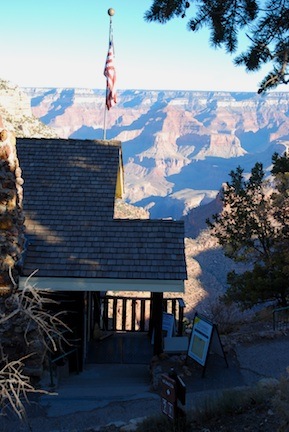
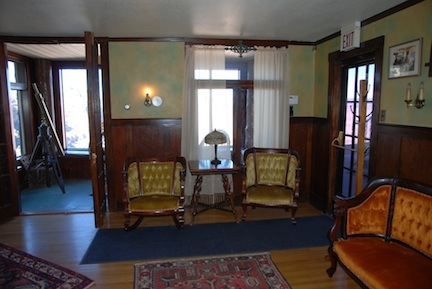
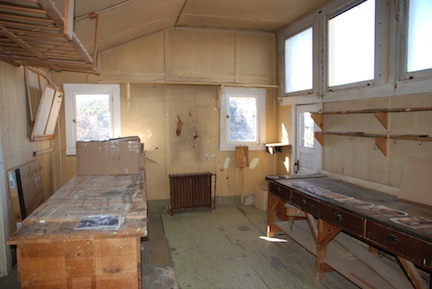
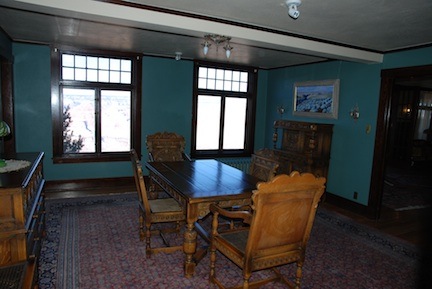
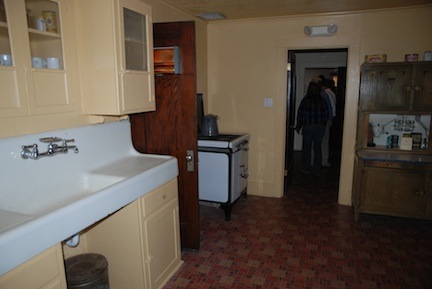
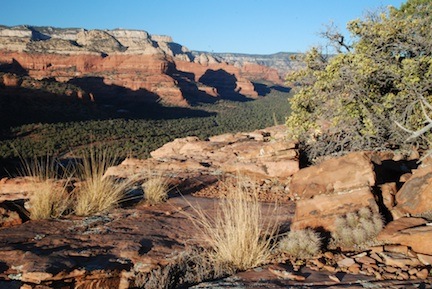 I’ve been experimenting quite a bit with foreground/background combinations. This shot of grasses, rocks, and trees with the red rocks in the distance behind them really called out to me. The foreground elements are on the mesa top. About 10 feet beyond them is a sheer cliff with a drop of 300-400 feet. The green trees you see beyond that are full-sized pinon and juniper pines. The red rock cliffs are several miles away. This one’s a “keeper” that I’ll likely put in my
I’ve been experimenting quite a bit with foreground/background combinations. This shot of grasses, rocks, and trees with the red rocks in the distance behind them really called out to me. The foreground elements are on the mesa top. About 10 feet beyond them is a sheer cliff with a drop of 300-400 feet. The green trees you see beyond that are full-sized pinon and juniper pines. The red rock cliffs are several miles away. This one’s a “keeper” that I’ll likely put in my 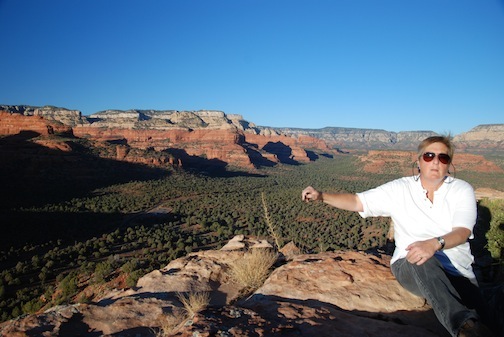 This second shot is a self-portrait. I broke my third wired shutter release and there’s no way I could have used the self-time for this. So I used the camera remote. Of course, the sensor for the remote is on the camera’s right side (when looking at the front) and I was sitting at the left. Hence the stretched out arm and rather cranky look on my face. It’s a dopey picture and I look like an idiot. I guess that’s why I like it.
This second shot is a self-portrait. I broke my third wired shutter release and there’s no way I could have used the self-time for this. So I used the camera remote. Of course, the sensor for the remote is on the camera’s right side (when looking at the front) and I was sitting at the left. Hence the stretched out arm and rather cranky look on my face. It’s a dopey picture and I look like an idiot. I guess that’s why I like it.